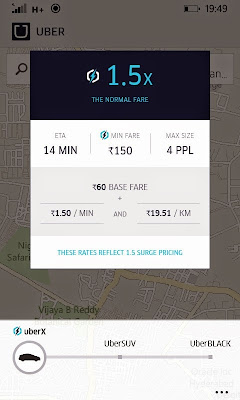
|
| Surge Pricing : How to avoid paying more? |
Extra charge = Surge price (I guess.)
Surge mostly depend upon driver's availability and customers demand which is very dynamic, one cannot predict it so Uber developed complex algorithms to do it.
I have taken 1000+ free rides, I have booked uber most of the time of day.
The time is better when there is low demand for Uber .
I have seen surge price all the time but there are few low demand time slots as per my observation.
- morning 6am to 9 am
- day time between 11 am to 5 pm
- night after 11 pm to morning 3
Other then that mostly there will be surge.
How Avoid uber surge pricing:
- Delay your ride.
- Look for near buy surcharge rate by sliding/moving map left-right-up-down.
- Take a walk, its good for health.
- Take a short trip to low or no surcharge area then book again to same or other cab.
Surge Pricing is one of the way to charge you more while there is high demand or less availability. This is the way to manage demand and supply and compensate more to drivers.
Uber is a relatively new and quickly growing business. It does not have any sort of responsibility to its customers to keep prices low. It is trying to make money, as companies often want to do.
If you don't want to pay a crazy-high fare tonight, you're in luck because Uber is not the only method of transportation available and nobody is making you use Uber (or OLA, or any other ride-hailing service).
You can walk. You can try to call or hail a cab. You can take a local train or a bus if you live in a city Or you can wait a few hours, since Uber surge changes in every 2 mins.What’s surge pricing exactly? Here’s what the company’s website has to say:
Uber rates increase to get more cars on the road and ensure reliability during the busiest times. When enough cars are on the road, prices go back down to normal levels. It’s important to know that you’ll always be notified in big, bold print if surge pricing is in effect. When rates are more than double, the surge confirmation screen also requires you to type in the specific surge multiplier to ensure you understand what rates to expect.
Uber’s surge pricing has been one of the least popular features of the business, which is strange: Uber is a luxury product, after all, and dynamic pricing is a common feature of similar services with fixed short-term supply and fluctuating demand—airlines, railways, and hotels, for example. It’s almost a shame that surge pricing has attracted such ire, because real-time prices are one of the few proper innovations that Uber’s platform can generate, and if done right it can actually help riders who are willing to pay a bit more get a car sooner, and help drivers make a bit of extra cash.
This new research will be music to Uber CEO Travis Kalanick’s ears: It turns out that taxi drivers are exactly the income-maximizing, labor-optimizing robots that neoclassical economics expects them to be.
Surge pricing is bad for riders, and you are in luck, you can avoid it.
There are two ways to avoid high price.
Surge Drop and Surge Protector
1. Surge Drop (Provided by Uber)
HOW IT WORKSGet more info here
1. Tap the NOTIFY ME IF SURGE ENDS button
2. Confirm that you’d like us to send you a Push Notification if surge drops
3. Stick around or start saying your goodbyes; the choice is yours
2. Surge Protector (Built using Uber API)
"During rush hour, Uber is more expensive"
Once the app finds the nearest location without surge pricing, it will then transfer the user over to the Uber app, inputting the non-surge location as a starting point. If nowhere within a one-kilometer radius of the user is surge-free, the app will find the lowest possible surge value—reducing what would have been a 3x surge to a 2x, for example.More info
There is no limit on surge pricing, it can many folds like 9x. Here is an incident happened with a birthday girl. Read it to know how she managed to overcome with the uber charges whcih was $362.57.
Uber cab service account Sign up to get first free ride
